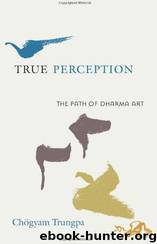True Perception: The Path of Dharma Art by Chogyam Trungpa & Judith L. Lief

Author:Chogyam Trungpa & Judith L. Lief
Language: eng
Format: azw3, epub
ISBN: 9781590305881
Publisher: Shambhala
Published: 2008-11-11T00:00:00+00:00
Nobody’s World
There are three types of perception: the sense of experience, the sense of emptiness, and the sense of luminosity. With those three levels of perception, we are able to see all the patterns of our life. Whether the patterns of our life are regarded as neurotic or enlightened, we are able to see them very clearly.
IN RELATING WITH the world, there are some very tough questions: what is the world, whose world is it, and what does relating mean? The basic point is that this is nobody’s world, since there is nobody as such. The energy that is constantly taking place does not belong to anybody but is a natural, organic process. Nevertheless, we function as if the world does belong to us, as if I have myself, as if I do exist. From this point of view, the nonexistence of ego—that primordial state of thisness or solid fixation—is not a philosophical matter, but simply a matter of perception. Perception is unable to trace back its existence to its origin. So each perception becomes sheer energy, without a beginner of the perception and without substance—just simple perception.
Perception can be categorized into three levels: experience, emptiness, and luminosity. At the first level, experience, perception is not meaningful self-confirmation, but the experience of things as they are. White is white and black is black. There is a kind of exuberant energy that goes along with the perception. You actually experience something as though you were it. You and the experience become almost indivisible when you experience something in that way. It’s that kind of direct communication without anything between.
The second level is the perception of emptiness, which is the absence of things as they are. That is, things have their space; they always come with a certain sense of room. Despite the complexities or the overcrowdedness of our experience, things provide their own space within the overcrowdedness. Actually, that is saying the same thing: overcrowdedness is room, in some sense, because there is movement, dance, play. Things are very shifty and intangible. Because of that, there is a very lucid aspect to the whole thing.
The third level of perception is luminosity. Luminosity has nothing to do with any visually bright light but is a sense of sharp boundary and clarity that does not have a theoretical or intellectualized reference point. It is realized on the spot, within the spaciousness. If there were no space, it would be unfocused; there would be no sharpness. But at this third level, in terms of ordinary experience, we have a sense of clarity and a sense of things as they are seen as they are, unmistakably.
So there are three types of perception: the sense of experience, the sense of emptiness, and the sense of luminosity. With those three levels of perception, we are able to see all the patterns of our life. Whether the patterns of our life are regarded as neurotic or enlightened, we are able to see them very clearly. That seems to
Download
True Perception: The Path of Dharma Art by Chogyam Trungpa & Judith L. Lief.epub
This site does not store any files on its server. We only index and link to content provided by other sites. Please contact the content providers to delete copyright contents if any and email us, we'll remove relevant links or contents immediately.
The Way of Zen by Alan W. Watts(6452)
Ego Is the Enemy by Ryan Holiday(5228)
The Art of Happiness by The Dalai Lama(4009)
The Book of Joy by Dalai Lama(3857)
Why Buddhism is True by Robert Wright(3372)
Spark Joy by Marie Kondo(3190)
Shift into Freedom by Loch Kelly(3098)
Happiness by Matthieu Ricard(2958)
A Monk's Guide to a Clean House and Mind by Shoukei Matsumoto(2842)
The Lost Art of Good Conversation by Sakyong Mipham(2503)
The Meaning of the Library by unknow(2470)
The Unfettered Mind: Writings from a Zen Master to a Master Swordsman by Takuan Soho(2204)
The Third Eye by T. Lobsang Rampa(2204)
Anthology by T J(2121)
Red Shambhala by Andrei Znamenski(2120)
The Diamond Cutter by Geshe Michael Roach(1994)
Thoughts Without A Thinker: Psychotherapy from a Buddhist Perspective by Epstein Mark(1937)
Twilight of Idols and Anti-Christ by Friedrich Nietzsche(1808)
Advice Not Given by Mark Epstein(1796)
